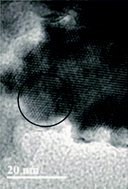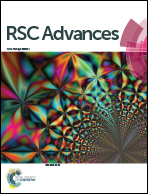The preparation of hydroxyapatite from unrefined calcite residues and its application for lead removal from aqueous solutions†
Abstract
Calcite originating from waste treatment technologies was utilised for the chemical precipitation of hydroxyapatite (HAP). The physicochemical properties of the as-synthesised-HAP was fully characterised using FT-IR, BET, SEM and TEM, confirming its crystal structure and formation of high purity HAP by XRD. The product was employed for removal of lead from aqueous media at pH 5.0, achieving almost 80% of the adsorption in the first 5 min and a maximum adsorption capacity for Pb2+ of 224.4 mg g−1. A contact time of 40 min was required to achieve equilibrium with Pb2+ uptake of 98%. The kinetics of the cation exchange of HAP from calcite were predicted using integrated rate laws, revealing a pseudo-second order cation exchange process with a rate constant of 6.84 × 10−4 g (mg min)−1. All obtained results are benchmarked against a control HAP sample simultaneously derived from eggshells, which were demonstrated to offer slower kinetics of cation exchange (4.82 × 10−4 g (mg min)−1) and almost half the maximum adsorption capacity (129.1 mg g−1). The results showed that hydroxyapatite synthesised from calcite waste represents a low-cost material for the adsorption of hazardous Pb2+ in contaminated waters and a promising alternative for heavy metals remediation in aquatic environments.



 Please wait while we load your content...
Please wait while we load your content...